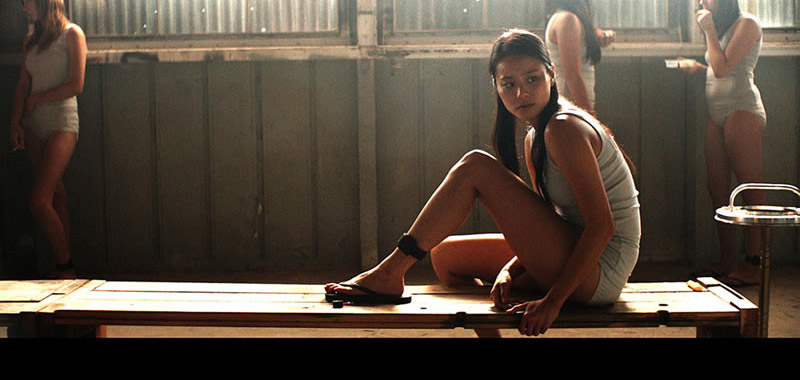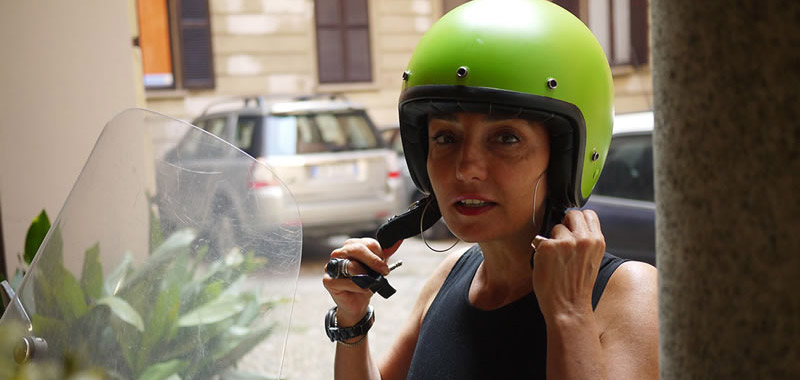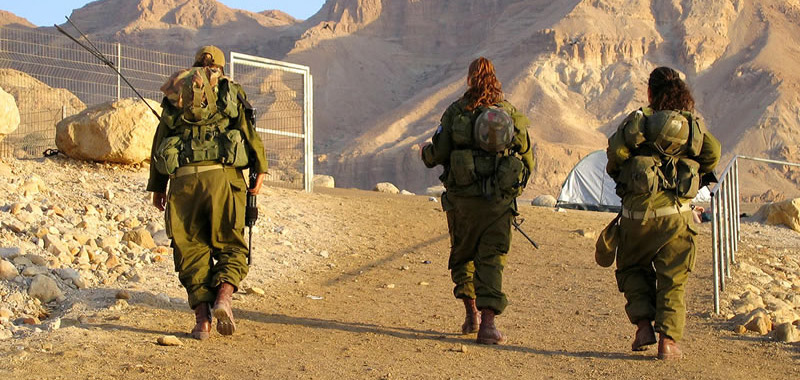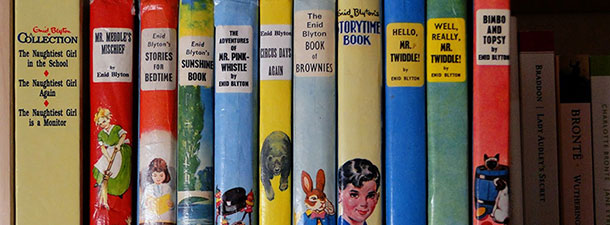
Eden: A Film Journey into Human Bondage
October 1, 2013
The Most Powerful Woman in Italy Has Got Your Number
October 1, 2013A Woman’s Place is on the Front Line: The Evolution of Female Combat Soldiers

Female soldiers on patrol
There is nothing new under the sun. This includes the phenomenon of women taking part in combat. It is only in our short-sighted, modern view that we see this as something strange, something innovative, even something of an anathema. War – like most impersonal forces – does not discriminate particularly. It rains on men and women alike and always has. The story of women at war is an ancient and honourable one that cries out to be told.
The field of battle after Waterloo was a scene of such terrible carnage that Lord Wellington, breaking from his usual, legendary sangfroid, reflected that ‘Nothing except a battle lost can be half so melancholy as a battle won’. Few battles in history have been so closely scrutinised as the bloody contest that ended Napoleon Bonaparte’s ambitions once and for all. Yet there is an anomaly recorded in the aftermath of the battle that still baffles military historians. Two British soldiers, seeking to identify wounded survivors, came upon the body of a strikingly beautiful woman dressed in the full uniform, helmet and breastplate armour of the Cuirassiers, the French heavy cavalry. She lay dead alongside her male comrades, who had been decimated in Marshal Ney’s impetuous, last-ditch attempt to reverse the fortunes of the day in a doomed mounted attack against the stout British infantry squares that mauled them.
Her identity remains a mystery. Legend has it that her lover was in the same regiment and she followed him into the fray. We will never know the full truth, but at the very least it seems clear that she met her end riding in the last great cavalry charge of the Napoleonic Wars. She died as a combatant, together with some of the most feared horsemen of the Imperial Grande Armée. In today’s parlance she was a frontline soldier killed in action; her appearance then seemed an apparition, perhaps a romantic literary invention of Sir Walter Scott or James Fenimore Cooper. Her sacrifice in battle, though, was entirely real.
Nearly two centuries later, in an age of digital warfare, smart bombs and drone strikes, where horsed cavalry has all but gone the way of the dodo, this year the most powerful armed forces in the world, those of the United States, officially rescinded the regulations that barred women serving in the military from combat roles. NATO ally Norway has also broken new ground in being the first country in history making military service obligatory for men and women. Both of these measures, as well as changing attitudes in many other armies towards female combat soldiers, herald a new era that will redefine women’s role in warfare and the manner in which society regards them as defenders of the nation.
Of course, women – like men – have always known war and not merely as its victims or the bereaved. Across the centuries women have actively served in combat. They have fought as both soldiers of the state and as guerrilla insurgents, not infrequently displaying great valour. They have sometimes led the way, commanding entire armies. Upon closer scrutiny, what seems new today in the context of military culture is merely the logical progression of an ongoing fight for equality faced by women in every other societal realm. It has been a long march, however, for women at arms.
There were other women at Waterloo too: wives of officers and ordinary soldiers who had accompanied their men to care for them when they weren’t in the line, who were accustomed to life on the march – often with children in tow – ministering to their men’s wounds and burying them when they died. As long as armies have campaigned there have been willing female camp followers of all kinds. Inevitably some were itinerant prostitutes (many of them destitute refugees, orphans and widows born of war, poverty and hunger with no other means and few more palatable choices for survival), for where there are armies, there is vice and much worse. But the vast majority, in the age of the flintlock and sword, were devoted wives and sweethearts, while others were sutlers who sold provisions to the soldiers that augmented their monotonous (and often meagre) issue rations. They too, having formed close emotional ties through shared experience, also often married the soldiers to whom they provided the indispensable foodstuffs, tobacco and wine.
When the common soldiers’ lot on campaign meant a strong probability of maiming (usually followed by destitution and beggary if they survived) or death by violence or disease, in today’s military argot, the women with the column were ‘force multipliers’ that played a vital role in ‘unit cohesion’. Women helped to bind and unite the social and psychological fabric of armies and preserved their fighting spirit in every encampment, reinforcing regimental loyalties and soldierly camaraderie by expanding a sense of familial community and normality as close to civilian life as was possible. They took their duty seriously and they reminded the men of theirs. The French armies of the late eighteenth century and subsequent Napoleonic era were more forward-thinking in their attitudes to this reality than others. They formally recognised the presence of women in the ranks by creating uniformed corps of female Cantinières, a model soon copied throughout Europe and across the Atlantic on both sides of the American Civil War, later in the nineteenth century. They may not have been dashing Cuirassiers on cavalry steeds, but tales of Cantinières shouldering muskets in the heat of battle appear too often in soldier’s diaries to be discounted. Cantinières sometimes DID fight and die for the regiments they loved and belonged to just as men did, but their auxiliary role has overshadowed their every-day heroism in historical memory.
In an era when army medical care was at best lethally primitive and inadequate to the task, Cantinières were invaluable aiding the wounded and the sick and would today be regarded as de facto battlefield medics and frontline nurses. Well before Clara Barton and Florence Nightingale revolutionised military medicine, the Cantinières were ably tending to the men who fell in battle in circumstances that would make modern corpsmen blanch. Slowly, however, Cantinières would fade from the battlefield, as armies reverted to all male enclaves. The last Cantinières to see service were in the Royal Spanish Army during the first ‘Rif ’ campaigns of the early twentieth century in what is today the disputed, former Spanish Sahara.
If we turn back to antiquity we can readily summon British warrior Queen Boudicca leading her Welsh Iceni tribe in a fierce uprising against Roman occupation as an example far and exceeding the Cantinière – not a woman following armies, but rather a woman masterminding military leadership, in warfare of the highest order, against the dominant martial power of her time. Catholic mystic Jeanne d’Arc and noblewoman Caterina Sforza both ably led armies later in the fifteenth century in France and Renaissance Italy. And Jeanne and Caterina not only led armies, they trained them and indoctrinated them personally.
But arguably it is in East Africa on the eve of the twentieth century that a woman leading sizeable forces in the field first-hand achieves the greatest modern distinction to date, in her direct contribution to a larger, collective, unparalleled military success. On March 1, 1896 at the battle of Adwa, Taytu Betul, Empress Consort of the Ethiopian Empire, wife of Emperor Menelik II, led, alongside her husband, a division of imperial troops against the invading Italian army headed by General Oreste Baratieri. Empress Betul commanded the Ethiopian artillery batteries which proved so critical in smashing the tactically inept Italians, who were overwhelmed and easily outmanoeuvered by the more agile Ethiopian infantry and cavalry led by Menelik’s other subordinates. The Italians were further hampered by their disorganisation, poor morale and their hapless commander who was later judged by military tribunal as ‘unfit to command’, but the outcome is no less remarkable for the lack of Italian military prowess shown that day.
The battle resulted in the virtual annihilation of the Italian force, leaving some 8500 dead and wounded enemy Italian and colonial troops and yielding 3000 more prisoners and vast quantities of captured arms and materiel. Adwa, also remembered as ‘Adua’ in Italy, constituted the most catastrophic and complete defeat of a large, colonial Western army ever inflicted by a “native” army in the entire history of Africa’s colonial wars. The victory preserved the independence of Ethiopia, which was, together with tiny Liberia, then the sole sovereign nation in Africa. It shattered the myth of European invincibility and inspired anti-colonialists everywhere for generations to come.
Not long after Adwa, the intensified bloodletting of the Boer and Russo- Japanese wars did not see women take a prominent frontline role in uniform, although reportedly a lone woman Cossack officer served in the Russian ranks at the Battle of Mukden in Manchuria, the largest land battle to take place in Asia until the Second World War. On the whole, during the Great War, while civilian women at home played a massive role sustaining the collective war effort, women served the rival armies primarily as nurses, not in combat – though they were sometimes dangerously close to the trenches in forward aid stations.
As the Russian Civil War, however, spread its ideological struggle to neighbouring, newly independent Finland, some two thousand workingclass, Finnish women flocked to join the Red Guards (a move not mirrored within their opponents’ ranks) and fought, many of them dying in battle or routinely summarily executed upon capture by the ultimately victorious Whites led by Marshal Mannerheim. The response of the Finnish women was later echoed in far larger numbers by the voluntary enlistment of numerous Spanish women in the Republican militias who stood against Franco’s Fascist soldiers in the early stages of the Civil War there in 1936. The apogee of this development prior to the post-colonial era was reached in Nazi-held Yugoslavia, where no less than an estimated 100,000 female partisans fought alongside their male comrades in the only irregular guerrilla force in the whole of occupied Europe to evolve into a standing army – one which tied down a large, conventional Axis force, something no other resistance fighters achieved. We can thus consider the many female Viet Cong, Eritrean, Kurdish, Tamil and Chechen guerrillas of the post-war and contemporary periods as inheritors of the tradition forged in the Balkans. In parallel to the women resistance fighters that were present in every underground movement in the Second World War, the official secret operatives of the Allied Forces from organisations such as Britain’s famed Special Operations Executive created a new arena for women to excel in the most rarified and difficult dimension of war, clandestine operations. Deep cover infiltration, ambushes and raids, sabotage of high value infrastructure, prison breaks, covert intelligence gathering and deception far inside enemy held territory as well as every other imaginable secret activity, including the rescue of downed airmen and the creation of escape corridors and communications networks, were the stock and trade of these elite women warriors.
Trained as commandos, fluent in the languages spoken where they operated, often inserted alone via night parachute drops to their assignments and functioning independently or in tandem with partisans, scores of Allied female agents fought their shadow war superbly; they achieved results far beyond their numbers for the larger war effort, not least in delivering critical intelligence and sowing chaos in the key German rear areas in advance of the final assault on D-Day. Many, like the spectacular Noor Inayat Khan, a legendary SOE operator, were eventually captured, tortured and executed, or died in concentration camps. But there was never a shortage of female volunteers for this most hazardous and lonely underground war duty. The real life models for James Bond, that Royal Navy Officer created by author Ian Fleming, himself a clandestine wartime operator on His Majesty’s Service, wasn’t always a man.
All told, millions of women wore the uniform of the Allied armies most, admittedly, with more mundane but no less essential roles than their cloak-and-dagger sisters in the SOE. But these duties did not entail simply reasonably safe administrative tasks. From the aircraft plotters of the Royal Air Force that scrambled fighter planes to help defeat the Luftwaffe in the Battle of Britain, to anti-aircraft gun crews, to frontline field hospitals and supply convoys, to military police, many women faced the guns and the bombs. Others took on an even more aggressive role, especially on the Russian Front. For example, the 2000 female snipers of the Soviet Army saw action in every major battle in the East, where the greatest carnage was wrought in the whole of the conflict, including the sieges of Leningrad and Stalingrad, the worst sieges of the war alongside Nanjing. Only 500 of them would survive, among them Lyudmila Pavlichenko, the top sharpshooter of them all with 309 confirmed German kills. It does baffle imagination given Lyudmila’s and her comrades’ war record how detractors of women in combat rationalise that female soldiers lack both the fortitude to endure battle and the cold-blooded will to kill the enemy so intrinsic to the frontline soldier’s elemental métier. Soviet women also distinguished themselves as combat aviators, most notably as night bomber pilots, flying rickety, slow, outmoded biplanes that nonetheless allowed them to rain down destruction on the occupiers of their country with marked skill. Their casualties were also extremely high and as a matter of fearful respect the Germans would dub them the ‘Nightwitches’. There were also countless other decorated women on the Western Front, in the Pacific Theatre and North Africa – too many of them to list them here. But history has not lionised and remembered them evenly. If just one is chosen to symbolise their courage and tenacity then it is difficult not to mention Englishwoman Susan Travers, the only woman to ever serve as a full-fledged member of the immortal French Foreign Legion. Travers saw active duty for the whole of the war – in Finland, the Middle East, including the Free French battles in Syria and Libya and notably at the battle of Bir Hakim, in the gruelling mountain fighting of the Italian campaign, the liberation of France and the invasion of Germany. She won both the Legion of Honour and the Croix de Guerre for driving a general’s staff car, a field ambulance and a self-propelled anti-tank gun at different junctures under heavy fire.
Women incontestably played a vital role in helping to secure Allied victory in the most destructive and far-reaching war humanity has ever known. Yet in most of the nearly seventy years since, the tired prejudices which kept women from taking their place in the vanguard of armies have held sway. Since the early 1990s, however, women started breaking the barriers again as combat roles opened up in naval and air forces in various armies, particularly in NATO countries. But the obstacles for an equal role for women remained in ground forces. Women were judged as undesirable and unsuitable for the close combat of infantry fighting because of assumed inferior physical strength, an inadequate emotional temperament, and the folly of the supposed negative impact that female combat casualties would have on their male fellow soldiers morale – a direct inference that women on the front line would cause combat units to disintegrate psychologically and thus militarily.
But warfare is a fluid beast and it evolves and transforms to reflect and absorb and adapt to the larger changes of civilisation. This is so not just in technology, but also in society’s cultural norms and geopolitical upheavals. The New World Order that US President George H.W. Bush said would ensue in the wake of the Cold War’s conclusion has turned out to be anything but. Instead the world is undergoing seismic changes in international relations and although some conventional wars will likely be fought in the future, unconventional warfare will remain the natural extension of the new world disorder that prevails from the counter-insurgencies, guerrilla and terror campaigns and ongoing revolutions (including those yet to come) of the Middle East, Central and South Asia and Africa, to the narco-wars of Latin America. What armed conflict will be sparked by a potentially looming, deeper global financial collapse is anybody’s guess. But things didn’t turn out so well after the last Great Depression.
In this vein, military women find the door to equal service under arms is opening wider. Above all, the nature of the fighting in Iraq and Afghanistan has forced a change in perspective from the outmoded, unimaginative, sexist and rigid thinking that has kept women as second-class soldiers. The conventional and clear-cut frontline of the past has blurred into an opaque prism in the contemporary era, where what we now label asymmetrical warfare predominates as the most common form of non-linear war fighting. There is no such thing as a safe rear area in the battlefields of Hindu Kush and bullets and improvised explosive devices do not discriminate according to gender. Women soldiers in Afghanistan, as in Iraq, serving in supposedly non-combatant roles have repeatedly found themselves in heavy combat.
They’ve been killed and wounded, just like other soldiers. They’ve also proven their mettle and won battlefield medals for bravery while their male comrades have managed to not lose their will to fight when their female comrades have fallen – not that they ever did in any war. GI Jane is not a coward, not a wallflower nor a weakling. She is a soldier holding the line like any other and the weight of history is in her favor. At a glance Australia, Canada, Denmark, France, Germany, Israel, New Zealand, Finland, Norway, Ireland, Poland, Sweden, Eritrea, and now the United States all allow women to serve as combat soldiers. Overcoming the enormous barrier of entrenched, hyper-conservative, Islamic sexism, even Pakistan and Afghanistan have their first female combat pilots and, somewhat surprisingly, have women soldiers serving in Special Forces units, the last bastion of male exclusivity in armies that otherwise have opened most combat categories to women (and presumably have never read about SOE’s exploits). Within NATO, women serve in Croatia’s crack Special Forces and British female soldiers also serve in the elite Special Reconnaissance Regiment, though they remain exempt from the better-known Special Air Service commandos. American women are still angling for a spot in Special Forces and inclusion in US Air Force Special Operations Squadrons may soon be a test case.
Much has changed, more will change, and at the very least women in the military have earned a new respect and standing within armed forces around the world. This long-overdue recognition should have been granted long ago, because time and again they have made the ultimate sacrifice, paying in blood for the terrible equality of a soldier’s wounds and death. One can only hope that their demonstrable courage, dedication and professionalism will also help effect societal change as moral currency for the liberation of women, full stop. But there’s far more to achieve yet. In the American military alone, the epidemic of institutional sexual abuse of women who serve is surrounded by far too much silence and impunity.
There is an enduring adage of frontline soldiering that the true test is all about the ‘man next to you’; that an inviolable bond exists between you and the closest comrade with whom you share the sting of battle. It is a sacred trust from an ancient warrior ethos that has bound all armies from the Phalanx to the Korengal Valley. It demands that each do his utmost to defend the other – if need be, unflinchingly, with one’s very life. It is a code all combat soldiers swear by, a martial mystique that steels them and keeps them moving headlong to close with the enemy in their most fearsome moments of utter terror, when inherent primeval survival instincts would otherwise counsel retreat or worse, surrender. It is the thing that defines a fighting soldier, the core essence and repository of martial honour, élan and identity in the profession of arms. It is the moral antithesis of the egotism so prevalent in post-industrial society. It is what made French paratroopers volunteer to jump at Dien Bien Phu to die with their fellows, when the battle was clearly lost to the Viet Minh and it is what made those left behind, unable to find a place on those transports, weeping on the runway. The substance of that ethos is not vainglory, but unconditional love.
There is now a difference: the comrade willing to fight to the end for you may not be another man, but rather a woman, not a brother but a sister in arms. She will not let you down. She never has.



